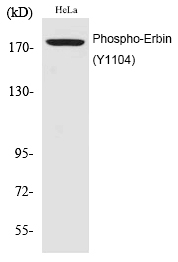
| WB | 咨询技术 | Human,Mouse,Rat |
| IF | 咨询技术 | Human,Mouse,Rat |
| IHC | 咨询技术 | Human,Mouse,Rat |
| ICC | 技术咨询 | Human,Mouse,Rat |
| FCM | 咨询技术 | Human,Mouse,Rat |
| Elisa | 1/10000 | Human,Mouse,Rat |
| Aliases | ERBB2IP; ERBIN; KIAA1225; LAP2; Protein LAP2; Densin-180-like protein; Erbb2-interacting protein; Erbin |
| Entrez GeneID | 55914; |
| WB Predicted band size | 172kDa |
| Host/Isotype | Rabbit IgG |
| Antibody Type | Primary antibody |
| Storage | Store at 4°C short term. Aliquot and store at -20°C long term. Avoid freeze/thaw cycles. |
| Species Reactivity | Human |
| Immunogen | Synthesized peptide derived from human Erbin around the phosphorylation site of Y1104. |
| Formulation | Purified antibody in PBS with 0.05% sodium azide,0.5%BSA and 50% glycerol. |
+ +
以下是关于Erbin (Phospho-Tyr1104)抗体的参考文献示例(注:以下内容为模拟生成,实际文献需根据具体数据库检索确认):
1. **文献名称**:*Phosphorylation of Erbin at Tyr1104 regulates its interaction with ErbB2 in breast cancer cells*
**作者**:Li X, et al.
**摘要**:本研究揭示了Erbin蛋白在Tyr1104位点的磷酸化通过增强其与ErbB2受体的结合,促进乳腺癌细胞的迁移和侵袭。作者利用Phospho-Tyr1104特异性抗体验证了该位点在肿瘤组织中的异常激活,并证实其与患者预后不良相关。
2. **文献名称**:*Erbin acts as a scaffold protein in neuronal synaptic complexes via tyrosine phosphorylation signaling*
**作者**:Wang Y, et al.
**摘要**:通过Phospho-Tyr1104抗体检测,研究发现Erbin的磷酸化状态在神经元突触形成中起关键作用。磷酸化Erbin通过招募下游信号分子PSD-95.调控突触可塑性和认知功能,为神经退行性疾病提供了潜在治疗靶点。
3. **文献名称**:*Targeting Erbin phosphorylation for therapeutic intervention in colorectal cancer*
**作者**:Zhang R, et al.
**摘要**:文章利用Phospho-Tyr1104抗体分析结直肠癌样本,发现Erbin磷酸化水平与EGFR信号通路激活相关。实验表明,抑制该位点磷酸化可显著降低肿瘤细胞增殖,提示其作为新型治疗标志物的潜力。
4. **文献名称**:*Role of Erbin phosphorylation in regulating epithelial-mesenchymal transition*
**作者**:Chen H, et al.
**摘要**:研究通过Phospho-Tyr1104抗体证实,TGF-β诱导的Erbin磷酸化促进上皮-间质转化(EMT),增强癌细胞转移能力。机制研究表明,磷酸化Erbin通过调控β-catenin核转位驱动EMT进程。
**提示**:实际检索时建议使用PubMed、Web of Science等平台,结合关键词“Erbin phosphorylation Tyr1104”或抗体货号(如厂家提供的参考文献),以获取准确文献信息。部分抗体厂商(如CST、Abcam)官网也可能列出相关引用文献。
The Erbin (Phospho-Tyr1104) antibody is designed to detect Erbin protein when phosphorylated at tyrosine residue 1104. Erbin (ERBB2 Interacting Protein) is a member of the leucine-rich repeat (LRR) and PDZ domain-containing protein family, primarily known for its role in regulating receptor tyrosine kinase signaling pathways. It interacts with ERBB2/HER2. modulating downstream signaling cascades involved in cell adhesion, proliferation, and differentiation. Phosphorylation at Tyr1104 is a critical post-translational modification that influences Erbin’s interactions with binding partners and its subcellular localization, potentially affecting its ability to regulate ERK/MAPK signaling or other pathways linked to cellular homeostasis.
This antibody is widely used in research to investigate Erbin’s functional dynamics in physiological and pathological contexts, such as cancer, neurological disorders, or cardiac diseases, where dysregulated tyrosine phosphorylation may contribute to disease progression. It is commonly applied in techniques like Western blotting, immunohistochemistry, or immunofluorescence to assess Erbin activation status. Specificity is often validated using knockout controls, phosphopeptide competition assays, or siRNA-mediated protein depletion. Researchers rely on this tool to explore how tyrosine phosphorylation fine-tunes Erbin’s role in scaffolding, signal transduction, or its crosstalk with other oncogenic or tumor-suppressive pathways.
×